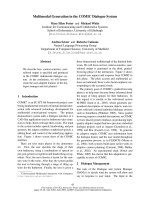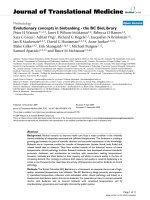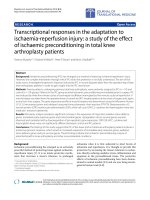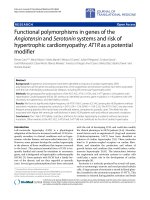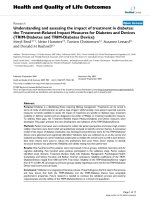báo cáo hóa học: " Participatory design in the development of the wheelchair convoy system" potx
Bạn đang xem bản rút gọn của tài liệu. Xem và tải ngay bản đầy đủ của tài liệu tại đây (708.2 KB, 10 trang )
BioMed Central
Page 1 of 10
(page number not for citation purposes)
Journal of NeuroEngineering and
Rehabilitation
Open Access
Research
Participatory design in the development of the wheelchair convoy
system
Vinod Sharma
1
, Richard C Simpson*
1,2,3
, Edmund F LoPresti
4
,
Casimir Mostowy
4
, Joseph Olson
2,3
, Jeremy Puhlman
3
, Steve Hayashi
3
,
Rory A Cooper
1,2,3
, Ed Konarski
5
and Barry Kerley
5
Address:
1
Department of Bioengineering; University of Pittsburgh; Pittsburgh, PA, USA,
2
Department of Rehabilitation Science and Technology;
University of Pittsburgh; Pittsburgh, PA, USA,
3
Human Engineering Research Labs; VA Pittsburgh Healthcare System; Pittsburgh, PA, USA,
4
AT
Sciences; Pittsburgh, PA, USA and
5
J. Iverson Riddle Development Center; Morganton, NC, USA
Email: Vinod Sharma - ; Richard C Simpson* - ; Edmund F LoPresti - ;
Casimir Mostowy - ; Joseph Olson - ; Jeremy Puhlman - ;
Steve Hayashi - ; Rory A Cooper - ; Ed Konarski - ;
Barry Kerley -
* Corresponding author
Abstract
Background: In long-term care environments, residents who have severe mobility deficits are
typically transported by having another person push the individual in a manual wheelchair. This
practice is inefficient and encourages staff to hurry to complete the process, thereby setting the
stage for unsafe practices. Furthermore, the time involved in assembling multiple individuals with
disabilities often deters their participation in group activities.
Methods: The Wheelchair Convoy System (WCS) is being developed to allow a single caregiver
to move multiple individuals without removing them from their wheelchairs. The WCS will consist
of a processor, and a flexible cord linking each wheelchair to the wheelchair in front of it. A
Participatory Design approach – in which several iterations of design, fabrication and evaluation are
used to elicit feedback from users – was used.
Results: An iterative cycle of development and evaluation was followed through five prototypes
of the device. The third and fourth prototypes were evaluated in unmanned field trials at J. Iverson
Riddle Development Center. The prototypes were used to form a convoy of three wheelchairs
that successfully completed a series of navigation tasks.
Conclusion: A Participatory Design approach to the project allowed the design of the WCS to
quickly evolve towards a viable solution. The design that emerged by the end of the fifth
development cycle bore little resemblance to the initial design, but successfully met the project's
design criteria. Additional development and testing is planned to further refine the system.
Background
Problem statement
The number of citizens requiring long-term care will more
than double by the middle of this century to 27 million
Published: 2 January 2008
Journal of NeuroEngineering and Rehabilitation 2008, 5:1 doi:10.1186/1743-0003-5-1
Received: 21 February 2007
Accepted: 2 January 2008
This article is available from: />© 2008 Sharma et al; licensee BioMed Central Ltd.
This is an Open Access article distributed under the terms of the Creative Commons Attribution License ( />),
which permits unrestricted use, distribution, and reproduction in any medium, provided the original work is properly cited.
Journal of NeuroEngineering and Rehabilitation 2008, 5:1 />Page 2 of 10
(page number not for citation purposes)
people [1]. Most of this increase will be due to aging baby
boomers but also includes a significant increase in adults
with various types of disabilities. One of the most impor-
tant, yet labor intensive, services of personal care is indi-
vidual mobility. An unpublished survey of three
intermediate care facilities (ICFs) for people with develop-
mental disabilities in the State of North Carolina con-
ducted by the J. Iverson Riddle Development Center
(JIRDC) found that, of 1410 residents, 655 (46%) had sig-
nificant mobility deficits that require the use of wheel-
chairs for travel but only 2% of these individuals were
able to use a powered wheelchair independently.
In ICFs, nursing homes, and other long-term care environ-
ments, residents who have severe mobility deficits move
about by being pushed in a manual wheelchair by a car-
egiver. Moving a group of residents between locations is
labor intensive, and requires at least three caregivers: one
to stay with residents at the starting location, a second to
stay with residents at the goal location, and a third to
move one person at a time from the start location to the
goal location.
This practice is inefficient and encourages staff to hurry to
complete the process, thereby setting the stage for unsafe
practices. Such practices could be responsible for injuries
to the residents or the staff (for example, back injuries due
to rushed movements and poor ergonomics). Further-
more, the time involved in assembling multiple residents
with disabilities often deters their participation in group
activities.
Removing the need for the one-to-one method for meet-
ing mobility needs would free staff to meet other personal
needs. To estimate savings in staff time, the number of
trips made by 6 residents (in varying group sizes) from
one of the homes at JIRDC was counted, along with the
number of staff required to make each trip. Trips were
analyzed from Monday through Friday for a typical week
of work and other activities. Weekend trips were not ana-
lyzed as they are unpredictable due to the varying activi-
ties of the residents. A total of 136 trips were found
necessary for the 6 residents to attend their typical weekly
vocational and recreational activities. Each person
required one staff person to assist in their movement,
meaning that 136 staff trips were required to accomplish
this travel schedule. If the residents could travel in a group
mode when appropriate, such that only one staff person
would be needed to accomplish the travel, only 76 staff
trips (a 44% reduction) would have been necessary to
accomplish the same travel schedule.
One option for group travel is a cart, van, or bus that trans-
ports non-ambulatory groups of people around a facility.
However, this solution has several drawbacks. For
instance, each person in a wheelchair must either use a
safety tie-down system or be transferred from their wheel-
chair to a secure seat. The time required to load and off-
load such a vehicle can be significant when working with
multiple wheelchair users. Infrastructure must also exist to
support access into and near the home pickup points and
sufficient tram staff to operate, load, unload and maintain
such a system.
An alternative is a system that allows a single staff member
to lead a "convoy" of self-propelled wheelchairs. The
Wheelchair Convoy System (WCS) will consist of a proc-
essor and a physical or virtual "linkage" between the
chairs. Initial development was conducted using a power
wheelchair and a digital camera, but the most recent pro-
totype is constructed on a JWI power-assist manual wheel-
chair and uses a mechanical linkage.
Related research
Several researchers have used technologies originally
developed for mobile robots to create Smart Wheelchairs
[2]. These devices typically consist of either a traditional
powered wheelchair to which a computer and a collection
of sensors have been added or a mobile robot base to
which a seat has been attached. Two North American
companies, Applied AI [3] and ActivMedia [4], sell smart
wheelchair prototypes based on modified power wheel-
chair bases, but neither system is intended for use outside
of a research lab. Applied AI's TAO-7 makes use of 13 IR
sensors, 8 ultrasonic sensors and 1 CCD camera to per-
form landmark-based navigation. ActivMedia's Robo-
Chariot makes use of shaft encoders and a laser range
finder to create a map of its environment, which can then
be used for localization and navigation.
The CALL Center of the University of Edinburgh, Scot-
land, has developed a smart powered wheelchair with
bump sensors, sonar sensors, and the ability to follow
tape tracks on the floor for use within a wheeled-mobility
training program [5]. This chair is sold in the United King-
dom (UK) and Europe by Smile Rehab, Ltd. (Berkshire,
UK) as the "Smart Wheelchair." Another relevant product
is the "Smart Box," which is also sold by Smile Rehab in
the UK and Europe. The Smart Box is compatible with
powered wheelchairs using either Penny and Giles or
Dynamics control electronics and includes bump sensors
(but not sonar sensors) and the ability to follow tape
tracks on the floor. Both the Smile Rehab Smart Wheel-
chair and Smart Box differ from the WCS in that they are
intended as mobility training devices rather than mobility
aids, both require constant active input from the wheel-
chair user in order to move, and neither product supports
group travel.
Journal of NeuroEngineering and Rehabilitation 2008, 5:1 />Page 3 of 10
(page number not for citation purposes)
Smart wheelchairs have been developed that follow mov-
ing targets using a variety of sensing modalities, and could
conceivably be used to form wheelchair convoys, though
none has been used for this purpose. The INRO smart
wheelchair used sonar sensors to track targets in order to
form convoys [6]. The Human Tracking and Following
System [7] uses a custom-built, highly directional, steera-
ble Wi-Fi antenna to track and follow a person carrying a
Wi-Fi enabled pocketPC. The Intelligent Wheelchair Sys-
tem from Osaka University [8] uses two cameras, one fac-
ing toward the user and the second facing forward. The
user provides input to the system with head gestures,
interpreted by the inward-facing camera. The outward-fac-
ing camera tracks targets and allows the user to control the
wheelchair with gestures when out of the wheelchair.
When the user looks straight ahead for a short time, the
outward-facing camera identifies the target and moves
toward it. Several other smart wheelchairs have also dem-
onstrated target tracking either with [9-13] or without
[14,15] machine vision.
Methods
Participatory design
The development process was guided by the framework of
Participatory Design. Based on Action Research [16], the
goal of Participatory Design is to produce both new tech-
nologies and organizational patterns in close cooperation
with end users [17]. A distinguishing feature of Participa-
tory Design is the use of multiple cycles of implementa-
tion, adaptation and evaluation driven by stakeholders
(as shown in Figure 1).
Participatory Design relies on participants' ability to envi-
sion how devices will look or will behave, often through
mock-ups and simulations [17]. Typical methods used to
elicit and evaluate ideas include examination of similar
products, metaphors, analogies, scenarios, role playing,
sketches, models and prototypes [17-20]. One observa-
tion from previous Participatory Design efforts is that
models and prototypes are more effective than drawings,
because they provide physical artifacts with which partic-
ipants can interact [18]. During the course of develop-
ment of the WCS, four separate prototypes were
constructed and evaluated, each of which is described
below. The first two prototypes were based on a powered
wheelchair and a laptop to facilitate rapid development.
The final two prototypes used a manual wheelchair frame
with powered wheelchair hubs.
Vision-based tracking implemented on a power wheelchair
The initial prototype of the WCS (see Figure 2) was based
on a midwheel drive power wheelchair. Three Sonaswitch
MiniA sonar sensors and a Logitech Quickcam Pro-4000
camera were mounted on the wheelchair lap tray. The
control software was written in Microsoft Visual C++ 6.0
The iterative cycles of action research and participatory design (from [24])Figure 1
The iterative cycles of action research and participatory
design (from [24]).
Journal of NeuroEngineering and Rehabilitation 2008, 5:1 />Page 4 of 10
(page number not for citation purposes)
and implemented on a Pentium III, 933Mhz, 528MB
RAM Toshiba Laptop. Computer vision was implemented
using the Intel OpenCV libraries [21]. Two PCMCIA data
acquisition cards were used to interface with the sonar
sensors and the wheelchair's motor controller.
The system was evaluated in unmanned tests in an office
building on the University of Pittsburgh campus. The
wheelchair tracked a moving target (one of the investiga-
tors wearing a green shirt) around the course shown in
Figure 3. The course spans a total distance of 142 meters
(155 yards), and includes numerous alcoves and outcrop-
pings. At its narrowest point, the course is 1.4 meters (4.5
feet) wide. No additional lighting beyond the existing
ambient light was provided, and one section of the course
was particularly dark due to a burned out light fixture. The
course was empty of moving objects, other than the inves-
tigator. The system successfully navigated the entire
course at a constant speed without colliding with an
obstacle.
The limiting factors in this prototype of the WCS were the
limited field of view of the camera, lack of degrees of free-
dom in the camera mounting, and the low quality of the
image. The field of view and lack of a pan-tilt mechanism
combined to place a lower bound on the turning radius
the WCS could achieve when tracking a target. If a target
moved too far to the side (corresponding to a very tight
turn), the target could leave the camera image before the
WCS had time to turn. Addressing this would have
required replacing the existing camera with a camera that
has a wider field-of-view or mounting the camera on a
pan-tilt unit.
Tracking based on a rigid mechanical linkage implemented
on a power wheelchair
Based on the shortcomings of the first prototype, an alter-
native design approach was pursued. The goal was to
develop a system that was more reliable than the first pro-
totype and capable of making tight turns. The approach
that was decided upon was a physical link between the
wheelchairs.
The second prototype WCS, shown in Figure 4, was imple-
mented using the same power wheelchair and laptop as
the first prototype. The second prototype used a tape
measure to provide a (semi-)rigid link between the lead-
ing and following wheelchair. A rotational encoder was
Course navigated by WCS while tracking a moving personFigure 3
Course navigated by WCS while tracking a moving person.
Semi-Autonomous Wheeled Mobility System (Prototype 1)Figure 2
Semi-Autonomous Wheeled Mobility System (Prototype 1).
Journal of NeuroEngineering and Rehabilitation 2008, 5:1 />Page 5 of 10
(page number not for citation purposes)
integrated with the tape measure to determine distance
between the wheelchairs and a second rotational encoder
was used to determine the angle between the wheelchairs.
The system was evaluated in unmanned tests using the
same navigation task as the first prototype (see Figure 3).
The course was empty of moving objects, other than the
investigator. The system successfully navigated the entire
course at a constant speed without colliding with an
obstacle. The wheelchair did not come to a halt during the
trial. The second prototype validated the idea of a
mechanical linkage between the wheelchairs. The system
was impervious to changes in lighting conditions, and the
lead wheelchair never left the trailing wheelchair's "field
of view."
Tracking based on a rigid mechanical linkage implemented
on a manual wheelchair
Based on the success of the second prototype, the next step
was to implement the system on a manual wheelchair
using a more refined mechanical linkage. A manual
wheelchair was targeted because that is the type of wheel-
chair most often used by the target user population of the
WCS. Initial designs focused on the Yamaha JWII push-
rim-activated power-assist wheelchair hubs [22,23], but it
was determined that the motors used by these hubs were
not sufficiently powerful to independently travel long dis-
tances with a passenger. Instead, Yamaha JWI powered
hubs were used. The JWI wheels can be mounted on a
manual wheelchair frame and driven with a joystick, with-
out the need for any propulsive force from the wheelchair
passenger.
The third prototype of the WCS is shown in Figure 5. The
prototype consists of a manual wheelchair frame, a Versa-
logic computer with built-in A/D and D/A boards and a
rigid mechanical linkage for connecting the lead wheel-
chair to the trailing wheelchair. The computer uses the
WindowsXP operating system and the control software
was written in Microsoft Visual C++ 6.0. The mechanical
linkage (shown in Figure 6) was fabricated from alumi-
num and consisted of a telescoping bar with clamps on
either side. Each clamp contained a rotary encoder, and
the telescoping shaft contained a linear encoder, allowing
the trailing wheelchair to track the distance and orienta-
tion of the lead wheelchair. The connection between the
joystick and motor controller for the JWI hubs was inter-
rupted and fed through the Versalogic computer, allowing
new motor command signals to be transmitted to the
motor controller based on the distance between, and rel-
ative orientations of, the two wheelchairs.
The third prototype successfully demonstrated the feasi-
bility of implementing the system on a manual wheel-
chair, but fell short in other areas. In particular, the rigid
mechanical linkage was heavy and the telescoping shaft
was unwieldy even when contracted to its shortest length.
A final prototype was constructed with the goal of incor-
porating a completely retractable physical connection
between the two wheelchairs.
Tracking based on a flexible mechanical linkage
implemented on a manual wheelchair
The fourth prototype, shown in Figure 7, was designed
based on a retractable string connection (actually, a dog
leash) between the two wheelchairs. The same manual
wheelchair, JWI hubs and Versalogic computer used by
the third prototype were also used. The linkage deter-
Semi-Autonomous Wheeled Mobility System (Prototype 3)Figure 5
Semi-Autonomous Wheeled Mobility System (Prototype 3).
Semi-Autonomous Wheeled Mobility System (Prototype 2)Figure 4
Semi-Autonomous Wheeled Mobility System (Prototype 2).
Journal of NeuroEngineering and Rehabilitation 2008, 5:1 />Page 6 of 10
(page number not for citation purposes)
mined the distance between the wheelchairs based on the
number of rotations of the spool holding the string, and
determined the angle between the leading wheelchair and
trailing wheelchair based on a second encoder connecting
the top of the spool to the trailing wheelchair. Unlike the
third prototype, there was not an encoder attached to the
leading wheelchair and the orientation of the leading
wheelchair was therefore not used to control the trailing
wheelchair.
Flexible mechanical linkage used by the fourth prototype of the WCSFigure 7
Flexible mechanical linkage used by the fourth prototype of the WCS.
Rigid mechanical linkage used by the third prototype of the WCSFigure 6
Rigid mechanical linkage used by the third prototype of the WCS. Left panel is a design drawing of the entire linkage. Right
panel is a detailed photo of one end of the linkage.
Journal of NeuroEngineering and Rehabilitation 2008, 5:1 />Page 7 of 10
(page number not for citation purposes)
As in the third prototype, the connection between the joy-
stick and motor controller for the JWI hubs was inter-
rupted and fed through the Versalogic computer, allowing
new motor command signals to be transmitted to the
motor controller. The motor command signals were deter-
mined based on the distance between the two wheelchairs
and the angle of the string connecting them. The distance
between the wheelchairs determined the trailing wheel-
chair's speed, and the angle of the string determined the
magnitude of turn.
Results
Unmanned trials of the third and fourth prototypes were
conducted on the JIRDC campus. The third prototype was
mounted on a manual wheelchair with JWI hubs how-
ever, because only one JWI was available for testing, the
fourth prototype was mounted on the powered wheel-
chair used by the first two prototypes. Both chairs were
linked together and led by a manual wheelchair to which
a powered front tiller (A "Roll-Aid" manufactured by
Stand-Aid, Inc. of Iowa) was attached, with the JWI (and
third prototype of the WCS) in the middle and the pow-
ered wheelchair (and fourth prototype of the WCS) trail-
ing. A picture of the experimental set-up is shown in
Figure 8.
Path navigation
The convoy of all three chairs was tested on a paved path
at JIRDC. The path was 164.6 m long, 243.8 cm at its wid-
est point and 172.7 cm at narrowest point. Two laps
around the path were completed in 11 minutes and 6 sec-
onds (5:39 for the first lap and 5:27 for the second lap).
At no point did any of the wheelchairs stop or leave the
path.
Slalom
The convoy of all three chairs was also tested on a slalom
course that was 58.5 m long and 3.7 m wide [Additional
file 1]. Each pole on the course was 20.3 cm by 20.3 cm,
and 2.2 m separated the front of one pole from the back
of the next pole. The convoy of three wheelchairs tra-
versed 11 poles in one direction, turned around, traversed
16 poles in the other direction, turned around again, and
traversed an additional 8 poles before the first collision
occurred (a total of 35 poles and two complete turns) in 6
minutes and 48 seconds.
Discussion
The WCS was developed in an iterative fashion, with mul-
tiple design and evaluation cycles. Lessons learned during
each cycle informed the design goals and evaluation crite-
ria in subsequent cycles. The design criteria that emerged
for the WCS by the end of the fourth development/evalu-
ation cycle were:
Cost
The system must fit within the operating budgets of ICFs.
Cost of the system can be amortized by allowing facilities
to use the system with multiple residents.
Compatibility
The system must be compatible with a variety of manual
wheelchair models and configurations. Passengers are
likely to have a wide variety of seating and positioning
needs, which must also be accommodated.
Simplicity
The system must be easy for caregivers to operate with
minimal training. There is significant turnover within
ICFs, and staff is often poorly educated.
Unobtrusiveness
The system must not interfere with normal operation of
the manual wheelchair when not in use.
Following the evaluation activities at JIRDC, meetings
were held with potential users at two facilities in the Pitts-
burgh area: Southwestern Veterans Center (SVC) and the
Children's Institute (CI). SVC is a residential long-term
care facility serving older and disabled veterans in south-
western Pennsylvania. The CI has a day school, outpatient
rehabilitation facilities, and a hospital.
Two additional design issues were identified that were not
relevant to JIRDC. JIRDC is a large multi-acre campus of
single-story buildings, whereas SVC and the CI are both
single buildings with multiple floors. The implication for
the WCS is that, whereas JIRDC values a solution that can
support convoys of multiple wheelchairs traveling long
distances, both SVC and the CI need a solution that allows
Configuration of wheelchairs for trials conducted at JIRDCFigure 8
Configuration of wheelchairs for trials conducted at JIRDC.
Journal of NeuroEngineering and Rehabilitation 2008, 5:1 />Page 8 of 10
(page number not for citation purposes)
shorter convoys to be quickly assembled and disassem-
bled to allow the use of elevators.
Another issue that was not relevant at JIRDC or SVC, but
arose at the CI, was the need to remove the WCS hardware
at the end of the day. Residents at JIRDC and SVC rarely
leave the facility, so there is no need to remove the WCS
hardware. Students at the CI, however, leave each day, and
need to be able to use their wheelchairs at home. A solu-
tion that works in environments like the CI, therefore,
must be easy to attach and detach.
During early iterations of the design/evaluation cycle, a
powered wheelchair and laptop computer were used for
rapid development and evaluation. The original intent
was to eventually transition to a manual wheelchair frame
and an embedded processor, and cease development of
the WCS for powered wheelchairs. In many cases, particu-
larly for individuals who are not able to operate a manual
or powered wheelchair independently, a manual wheel-
chair frame is desired because it is smaller, lighter and
more maneuverable. However, even individuals who are
able to operate a powered wheelchair independently
might occasionally benefit from the ability to join a con-
voy of wheelchairs. For example, the WCS may be useful
in evacuating an ICF in an orderly manner. Therefore,
development of the WCS will continue for both manual
wheelchairs (with powered hubs) and traditional pow-
ered wheelchairs.
Following testing at JIRDC, a fifth prototype (shown in
Figure 9) was developed. Unlike the fourth prototype, the
fifth prototype has components on both the leading and
trailing wheelchair, so that the trailing wheelchair can use
both its orientation and the leading wheelchair's orienta-
tion in its navigation calculations. Communication
between the two components is wireless, which allows the
connection between the two wheelchairs to be an inex-
pensive string.
A diagram of the current system is shown in Figure 10. The
convoy will initially be led by a wheelchair user or by a
caregiver holding the first component. Feedback from
stakeholders will be used to explore alternatives, includ-
ing (1) designing a special hand-held component or (2)
using computer vision on the first wheelchair in the con-
voy to track the caregiver.
Conclusion
Development of the WCS demonstrates the benefits of
Participatory Design in the context of developing rehabil-
itation technology. The original concept of the WCS,
based on computer vision and a wireless PDA-based user
interface, was dramatically different than the system that
was ultimately developed. Frequent evaluations, and
interaction with target users at JIRDC, provided valuable
guidance for each design cycle.
The WCS is expected to be useful in a variety of settings for
both manual and powered wheelchairs. Long-term care
facilities with large populations of residents who are not
independently mobile are one application of the WCS.
Another application of the WCS is within schools serving
large numbers of children with disabilities, where the
Flexible mechanical linkage developed for fifth prototype of the WCSFigure 9
Flexible mechanical linkage developed for fifth prototype of the WCS.
Journal of NeuroEngineering and Rehabilitation 2008, 5:1 />Page 9 of 10
(page number not for citation purposes)
WCS might only be used at the beginning and end of the
school day to facilitate bus loading and unloading. Simi-
larly, the WCS might also be useful as a tool for rapid and
orderly emergency evacuation of facilities with large num-
bers of people who use wheelchairs.
Competing interests
AT Sciences plans to apply for a patent for the Wheelchair
Convoy System. AT Sciences will be submitting a Phase I
SBIR proposal to the National Institutes of Health based,
in part, on the results contained in this manuscript. Dr.
Simpson is not employed by, nor does he hold any stocks
or shares in, AT Sciences.
Authors' contributions
RS, EL and RC conceived of the project and participated in
its design and coordination. RS drafted the manuscript. VS
conceived of the mechanical linkage approach. VS, JO, JP,
CM and SH implemented the hardware and software for
the system. All authors read and approved the final man-
uscript. BK and EK provided design feedback throughout
the project.
Additional material
References
1. Evaluation OotAfPa: The future supply of long-term care work-
ers in relation to the aging baby boom generation. In Book The
future supply of long-term care workers in relation to the aging baby boom
generation City: Department of Health and Human Services; 2003.
2. Simpson RC: Smart wheelchairs: A literature review. Journal of
Rehabilitation Research and Development 2005, 42:423-438.
3. Applied AI TAO Smart Wheelchair [ />tao_7.html]
4. ActivMedia RoboChariot [ />ROBOTS/RoboChariot.html]
5. Nisbet PD, Craig J, Odor JP, Aitken S: 'Smart' wheelchairs for
mobility training. Technology and Disability 1996, 5:49-62.
6. Schilling K, Roth H, Lieb R, Stutzle H: Sensors to improve the
safety for wheelchair users. In Book Sensors to improve the safety
for wheelchair users City; 1998.
7. Arora A, Ferworn A: Pocket PC beacons: Wi-Fi based human
tracking and following. In ACM Symposium on Applied Computing;
13–17 March; Santa Fe, New Mexico Edited by: Haddad HM, Liebrock
LM, Omicini A, Wainwright RL. ACM Press; 2005:970-974.
8. Kuno Y, Shimada N, Shirai Y: Look where you're going. IEEE
Robotics & Automation Magazine 2003, 10:26-34.
9. Argyros A, Georgiadis P, Trahanias P, Tsakiris D: Semi-autono-
mous navigation of a robotic wheelchair. Journal of Intelligent
and Robotic Systems 2002, 34:315-329.
10. Espinosa F, Lopez E, Mateos R, Mazo M, Garcia R: Advanced and
intelligent control techniques applied to the drive control
and path tracking systems on a robotic wheelchair. Autono-
mous Robots 2001, 11:137-148.
11. Kamiuchi S, Maeyama S: A novel human interface of an omni-
directional wheelchair. In Book A novel human interface of an omni-
directional wheelchair City: IEEE; 2004.
12. Luo RC, Hu CY, Chen TM, Lin M-H: Force reflective feedback
control for intelligent wheelchairs. In Book Force reflective feed-
back control for intelligent wheelchairs Volume 2. City: IEEE;
1999:918-923.
13. Miller DP: Moving in tandem: Automated person pacing for
wheelchair users. In Book Moving in tandem: Automated person pac-
ing for wheelchair users City: AAAI Press; 1996.
Additional file 1
Three chairs slalom. Video of three wheelchair convoy performing slalom
test.
Click here for file
[ />0003-5-1-S1.mov]
System diagram for fifth prototype of WCSFigure 10
System diagram for fifth prototype of WCS.
Publish with BioMed Central and every
scientist can read your work free of charge
"BioMed Central will be the most significant development for
disseminating the results of biomedical research in our lifetime."
Sir Paul Nurse, Cancer Research UK
Your research papers will be:
available free of charge to the entire biomedical community
peer reviewed and published immediately upon acceptance
cited in PubMed and archived on PubMed Central
yours — you keep the copyright
Submit your manuscript here:
/>BioMedcentral
Journal of NeuroEngineering and Rehabilitation 2008, 5:1 />Page 10 of 10
(page number not for citation purposes)
14. Prassler E, Scholz J, Elfes A: Tracking multiple moving objects
for real-time robot navigation. Autonomous Robots 2000,
8:105-116.
15. Jaffe DL: Ultrasonic head controlled wheelchair/interface: A
case study in development and technology transfer. In Book
Ultrasonic head controlled wheelchair/interface: A case study in develop-
ment and technology transfer City: RESNA Press; 1990.
16. Waterman H, Tillen D, Dickson R, de Koning K: Action research:
A systematic review and guidance for assessment. Health
Technology Assessment 2001, 5:.
17. Clemensen J, Larsen S, Kyng M, Kirkevold M: Participatory Design
in health sciences: Using cooperative experimental methods
in developing health services and computer technology.
Qualitative Health Research 2007, 17:122-130.
18. Allen J: Designing desirability in an augmentative and alterna-
tive communication device. Universal Access in the Information
Society 2005, 4:135-145.
19. Beynon-Davies P, Holmes S: Integrating rapid application devel-
opment and participatory design. IEEE Proceedings – Software
1998, 145:105-112.
20. Kensing F, Blomberg J: Participatory Design: Issues and con-
cerns. Computer Supported Cooperative Work 1998, 7:167-185.
21. OpenCV [ />]
22. Cooper RA, Corfman TA, Fitzgerald SG, Boninger ML, Spaeth DM,
Ammer W, Arva J: Performance assessment of a pushrim-acti-
vated power-assisted wheelchair control system. IEEE Trans-
actions on Control Systems Technology 2002, 10:121-126.
23. Cooper RA, Fitzgerald SG, Boninger ML, Prins K, Rentschler AJ, Arva
J, O'Connor TJ: Evaluation of a pushrim-activated, power-
assisted wheelchair. Archives of Physical Medicine and Rehabilitation
2001, 82:702-708.
24. Kemmis S, McTaggart R: The Action Research Planner 2nd edition. Gee-
long, Victoria, Australia: Deakin University Press; 1982.
